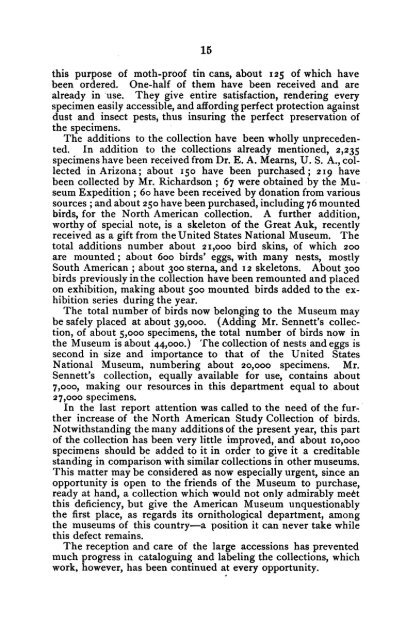1887-1888 - American Museum of Natural History
1887-1888 - American Museum of Natural History
1887-1888 - American Museum of Natural History
You also want an ePaper? Increase the reach of your titles
YUMPU automatically turns print PDFs into web optimized ePapers that Google loves.
15<br />
this purpose <strong>of</strong> moth-pro<strong>of</strong> tin cans, about 125 <strong>of</strong> which have<br />
been ordered. One-half <strong>of</strong> them have been received and are<br />
already in use. They give entire satisfaction, rendering every<br />
specimen easily accessible, and affording perfect protection against<br />
dust and insect pests, thus insuring the perfect preservation <strong>of</strong><br />
the specimens.<br />
The additions to the collection have been wholly unprecedented.<br />
In addition to the collections already mentioned, 2,235<br />
specimens have been received from Dr. E. A. Mearns, U. S. A., collected<br />
in Arizona; about I50 have been purchased; 2I9 have<br />
been collected by Mr. Richardson; 67 were obtained by the <strong>Museum</strong><br />
Expedition; 6o have been received by donation from various<br />
sources ; and about 250 have been purchased, including 76 mounted<br />
birds, for the North <strong>American</strong> collection. A further addition,<br />
worthy <strong>of</strong> special note, is a skeleton <strong>of</strong> the Great Auk, recently<br />
received as a gift from the United States National <strong>Museum</strong>. IThe<br />
total additions number about 21,000 bird skins, <strong>of</strong> which 200<br />
are mounted; about 6oo birds' eggs, with many nests, mostly<br />
South <strong>American</strong>; about 300 sterna, and 12 skeletons. About 300<br />
birds previouslv in the collection have been remounted and placed<br />
on exhibition, making about 5oo mounted birds added to the exhibition<br />
series during the year.<br />
The total number <strong>of</strong> birds now belonging to the <strong>Museum</strong> may<br />
be safely placed at about 39,000. (Adding Mr. Sennett's collection,<br />
<strong>of</strong> about 5,ooo specimens, the total number <strong>of</strong> birds now in<br />
the <strong>Museum</strong> is about 44,000.) 'Ihe collection <strong>of</strong> nests and eggs is<br />
second in size and importance to that <strong>of</strong> the United States<br />
National <strong>Museum</strong>, numbering about 20,000 specimens. Mr.<br />
Sennett's collection, equally available for use, contains about<br />
7,000, making our resources in this department equal to about<br />
27,000 specimens.<br />
In the last report attention was called to the need <strong>of</strong> the further<br />
increase <strong>of</strong> the North <strong>American</strong> Study Collection <strong>of</strong> birds.<br />
Notwithstanding the many additions <strong>of</strong> the present year, this part<br />
<strong>of</strong> the collection has been very little improved, and about io,000<br />
specimens should be added to it in order to give it a creditable<br />
standing in comparison with similar collections in other museums.<br />
This matter may be considered as now especially urgent, since an<br />
opportunity is open to the friends <strong>of</strong> the <strong>Museum</strong> to purchase,<br />
ready at hand, a collection which would not only admirably meet<br />
this deficiency, but give the <strong>American</strong> <strong>Museum</strong> unquestionably<br />
the first place, as regards its ornithological department, among<br />
the museums <strong>of</strong> this country-a position it can never take while<br />
this defect remains.<br />
The reception and care <strong>of</strong> the large accessions has prevented<br />
much progress in cataloguing and labeling the collections, which<br />
work, however, has been continued at every opportunity.

















